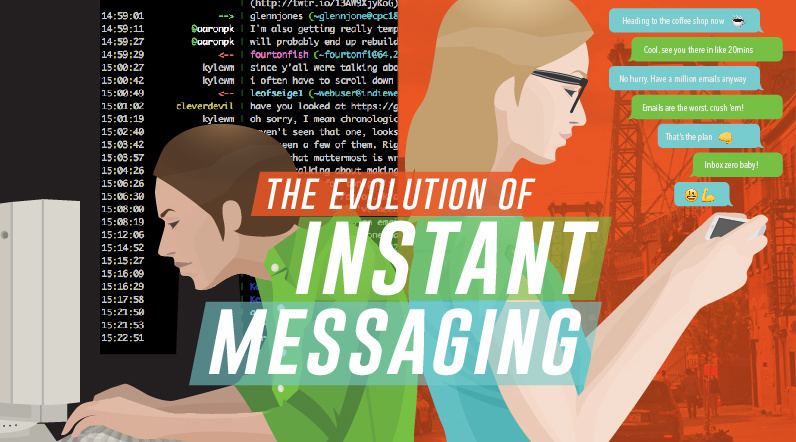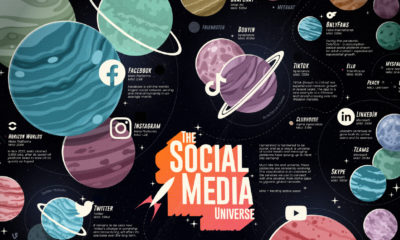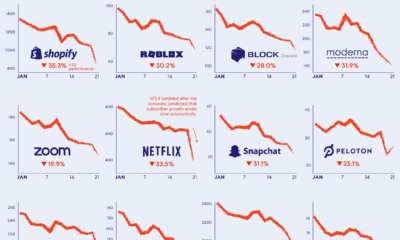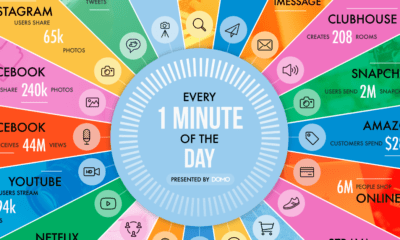Technology
The Evolution of Instant Messaging
The concept of instant messaging crossed into the mainstream in the 1990s, allowing friends, acquaintances, colleagues, and like-minded thinkers from all over the world to connect in real-time.
Since then, instant messaging has revolutionized how we communicate, and today over 2.5 billion people are signed up for at least one messaging app. The present IM experience is seamless, and it intuitively integrates features like video, photos, voice, e-commerce, and gaming with plain-old messaging.
However, despite the impressive features of dominant apps like Snapchat, Facebook Messenger, and Whatsapp, today’s technology would simply not be possible without the earlier breakthroughs of their more rudimentary predecessors.
Instant Messaging: Past, Present, and Future
The following infographic from Hello Pal, a messaging app allowing for instant translation, shows the evolution of instant messaging. It pays homage to the advancements made in the early days by apps such as ICQ or AIM, while also looking at the trends in IM that will surface in the coming years.

While messaging is commonplace today, it was only two decades ago that chatting with friends and strangers online was a revolutionary concept.
The History of Instant Messaging
1961 – MIT’s Compatible Time-Sharing System (CTSS), along with other multi-user operating systems, helps to pioneer instant messaging by allowing up to 30 users to chat in real-time.
1988 – Internet Relay Chat (IRC) allows users to connect to networks with client software to chat with groups in real-time. IRC peaked in popularity in the 1990s, but still has hundreds of thousands of users today.
The late 1990s sees the first major competing IM platforms arrive: ICQ, AIM, MSN, and Yahoo all fight for market share in the new instant messaging market.
1992 – The first SMS message, “Merry Christmas”, is sent over the Vodafone GSM network in the U.K. in December.
1996 – Israeli company Mirabilis launches ICQ, which allowed users to chat one-on-one or in groups, exchange files, and search for other users. At its peak in 2001, ICQ had over 100 million accounts registered.
1997 – AOL launches AOL Instant Messenger (AIM), which pioneers the “Buddy List” concept. By the mid-2000s, AIM has the largest share of the instant messaging market in North America with 52%.
1998 – Yahoo! Messenger launches, allowing users with a Yahoo! ID to connect.
1999 – Microsoft releases MSN Messenger, a competitor to AIM and Yahoo. By 2005, roughly 2.5 billion messages are sent each day on the platform.
1999 – Across the Pacific Ocean, Tencent Holdings launches its first successful app. It’s called QQ, and it is initially a near-exact clone of ICQ.
To many, the 2000s is a Golden Age for instant messaging. Sharing photos, making video calls, and playing games are now common platform features
2001: By this time, only 30 million SMS text messages are sent per month in the United States.
2002: Apple launches iChat for its Mac OS X operating system, which is compatible with AIM.
2003: Skype allows Internet users to communicate with others through video, voice and instant messaging.
2005: Google Talk, available in a Gmail user’s window, is launched to allow easy communication between email contacts.
2006: MySpace launches the first instant messaging platform built within a social network: MySpaceIM.
2006: Market Snapshot (US Market)
- AIM: 53 million
- MSN: 27 million
- Yahoo: 22 million
- Google: 866,000
2006: By this time, 12.5 billion SMS text messages were sent each month in the United States
2008: Facebook Chat is released, allowing Facebook users to message friends or groups of friends on the social network. (Later on, Facebook would release a standalone mobile app version called Facebook Messenger in 2011.)
2009: An upstart WhatsApp allows users to text, send video, and audio for free.
Instant messaging undergoes a renaissance in the 2010s, as new apps like Snapchat, WhatsApp, and WeChat change how the game is played.
The popularity of new platforms change the concept of messaging entirely:
WeChat (2011)
Initially started by Tencent as a clone of WhatsApp, WeChat is now much more than a chat app. It’s a fully integrated mobile platform with shopping, payments, games, and much more.
WeChat processed $46 billion in payments in January 2016 – that’s about as twice as much as Paypal.
Snapchat (2011)
Snapchat, which is popular with millennials, allows users to send “snaps” which disappear after an allotted amount of time.
The app has evolved into a mix of private and public content, including brand networks and coverage of live events.
Slack (2013)
Slack’s workplace collaboration software allows teams to communicate easily and efficiently.
Slack was the fastest company to hit “unicorn” status ever, taking just 1.25 years to be worth over $1 billion.
Technology
All of the Grants Given by the U.S. CHIPS Act
Intel, TSMC, and more have received billions in subsidies from the U.S. CHIPS Act in 2024.

All of the Grants Given by the U.S. CHIPS Act
This was originally posted on our Voronoi app. Download the app for free on iOS or Android and discover incredible data-driven charts from a variety of trusted sources.
This visualization shows which companies are receiving grants from the U.S. CHIPS Act, as of April 25, 2024. The CHIPS Act is a federal statute signed into law by President Joe Biden that authorizes $280 billion in new funding to boost domestic research and manufacturing of semiconductors.
The grant amounts visualized in this graphic are intended to accelerate the production of semiconductor fabrication plants (fabs) across the United States.
Data and Company Highlights
The figures we used to create this graphic were collected from a variety of public news sources. The Semiconductor Industry Association (SIA) also maintains a tracker for CHIPS Act recipients, though at the time of writing it does not have the latest details for Micron.
| Company | Federal Grant Amount | Anticipated Investment From Company |
|---|---|---|
| 🇺🇸 Intel | $8,500,000,000 | $100,000,000,000 |
| 🇹🇼 TSMC | $6,600,000,000 | $65,000,000,000 |
| 🇰🇷 Samsung | $6,400,000,000 | $45,000,000,000 |
| 🇺🇸 Micron | $6,100,000,000 | $50,000,000,000 |
| 🇺🇸 GlobalFoundries | $1,500,000,000 | $12,000,000,000 |
| 🇺🇸 Microchip | $162,000,000 | N/A |
| 🇬🇧 BAE Systems | $35,000,000 | N/A |
BAE Systems was not included in the graphic due to size limitations
Intel’s Massive Plans
Intel is receiving the largest share of the pie, with $8.5 billion in grants (plus an additional $11 billion in government loans). This grant accounts for 22% of the CHIPS Act’s total subsidies for chip production.
From Intel’s side, the company is expected to invest $100 billion to construct new fabs in Arizona and Ohio, while modernizing and/or expanding existing fabs in Oregon and New Mexico. Intel could also claim another $25 billion in credits through the U.S. Treasury Department’s Investment Tax Credit.
TSMC Expands its U.S. Presence
TSMC, the world’s largest semiconductor foundry company, is receiving a hefty $6.6 billion to construct a new chip plant with three fabs in Arizona. The Taiwanese chipmaker is expected to invest $65 billion into the project.
The plant’s first fab will be up and running in the first half of 2025, leveraging 4 nm (nanometer) technology. According to TrendForce, the other fabs will produce chips on more advanced 3 nm and 2 nm processes.
The Latest Grant Goes to Micron
Micron, the only U.S.-based manufacturer of memory chips, is set to receive $6.1 billion in grants to support its plans of investing $50 billion through 2030. This investment will be used to construct new fabs in Idaho and New York.
-

 Education1 week ago
Education1 week agoHow Hard Is It to Get Into an Ivy League School?
-

 Technology2 weeks ago
Technology2 weeks agoRanked: Semiconductor Companies by Industry Revenue Share
-

 Markets2 weeks ago
Markets2 weeks agoRanked: The World’s Top Flight Routes, by Revenue
-

 Demographics2 weeks ago
Demographics2 weeks agoPopulation Projections: The World’s 6 Largest Countries in 2075
-

 Markets2 weeks ago
Markets2 weeks agoThe Top 10 States by Real GDP Growth in 2023
-

 Demographics2 weeks ago
Demographics2 weeks agoThe Smallest Gender Wage Gaps in OECD Countries
-

 Economy2 weeks ago
Economy2 weeks agoWhere U.S. Inflation Hit the Hardest in March 2024
-

 Environment2 weeks ago
Environment2 weeks agoTop Countries By Forest Growth Since 2001














